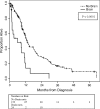Survival among women with triple receptor-negative breast cancer and brain metastases
- PMID: 19150943
- PMCID: PMC2722369
- DOI: 10.1093/annonc/mdn682
Survival among women with triple receptor-negative breast cancer and brain metastases
Abstract
Background: The purpose of this study was to determine the incidence of and survival following brain metastases among women with triple receptor-negative breast cancer.
Patients and methods: In all, 679 patients with nonmetastatic triple receptor-negative breast cancer diagnosed from 1980 to 2006 were identified. Cumulative incidence of brain metastases was computed. Cox proportional hazards models were fitted to explore factors that predict for development of brain metastases. Survival was computed using the Kaplan-Meier product limit method.
Results: Median follow-up was 26.9 months. In all, 42 (6.2%) patients developed brain metastases with a cumulative incidence at 2 and 5 years of 5.6% [95% confidence interval (CI) 3.8% to 7.9%] and 9.6% (95% CI 6.8% to 13%), respectively. A total of 24 (3.5%) patients developed brain metastases as the first site of recurrence with cumulative incidence at 2 and 5 years of 2.0% (95% CI 2.6% to 6.0%) and 4.9% (95% CI 3.2% to 7.0%), respectively. In the multivariable model, no specific factor was observed to be significantly associated with time to brain metastases. Median survival for all patients who developed brain metastases and those who developed brain metastases as the first site of recurrence was 2.9 months (95% CI 2.0-7.6 months) and 5.8 months (95% CI 1.7-11.0 months), respectively.
Conclusion: In this single-institutional study, patients with nonmetastatic triple receptor-negative breast tumors have a high early incidence of brain metastases associated with poor survival and maybe an ideal cohort to target brain metastases preventive strategies.
Figures


Comment in
-
Brain metastases and subtypes of breast cancer.Ann Oncol. 2009 May;20(5):803-5. doi: 10.1093/annonc/mdp246. Ann Oncol. 2009. PMID: 19403934 No abstract available.
References
-
- Perou CM, Sorlie T, Eisen MB, et al. Molecular portraits of human breast tumors. Nature. 2000;406:747–752. - PubMed
-
- Sorlie T. Molecular portraits of breast cancer: tumour subtypes as distinct disease entities. Eur J Cancer. 2004;40:2667–2675. - PubMed
-
- Brenton JD, Carey LA, Ahmed AA, et al. Molecular classification and molecular forecasting of breast cancer: ready for clinical application? J Clin Oncol. 2005;23:7350–7360. - PubMed
-
- Carey LA, Dees EC, Sawyer L, et al. The triple negative paradox: primary tumor chemosensitivity of breast cancer subtypes. Clin Cancer Res. 2007;13(8):2329–2334. - PubMed
Publication types
MeSH terms
Substances
Grants and funding
LinkOut - more resources
Full Text Sources
Medical

